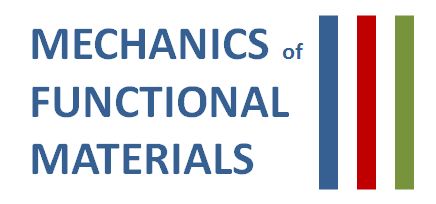-
![]() Picture: Min Yi
Picture: Min Yi![]() Picture: Min Yi
Picture: Min YiComputational study on microstructure evolution andmagnetic property of laser additively manufactured magnetic materials
2019/03/20
New Publication in “Computational Mechanics”
In this work, we will present the first attempt to computationally study the microstructure evolution and magnetic properties of magnetic materials (e.g. Fe–Ni alloys) processed by selective laser melting (SLM). The evolution and distribution of the γ -Fe–Ni and FeNi3 phase fractions are predicted by using the temperature information from FEA and the output from CALculation of PHAse Diagrams (CALPHAD).
-
![]()
![]()
Two-level modeling of lithium-ion batteries
2019/03/08
New Publication in “Journal of Power Sources”
In this work, we propose a two-level framework, which extends the P2D cell model and incorporates a mechanically coupled phase-field Cahn–Hilliard diffusion model of active particles. …
-
8th GACM Colloquium on Computational Mechanics (GACM 2019) on Aug. 28th-30th
2019/03/01
Bai-Xiang Xu and Marc-André Keip are organizing the Mini-Symposia entitled “MS22: Recent Trends in Phase-Field Modeling: Theory, Numerics, Applications” in 8th GACM Colloquium on Computational Mechanics (GACM 2019) in Kassel on Aug. 28th-30th.
-
![]()
![]()
Graduation in the Division Mechanics of functional Materials
2019/01/16
We congratulate our colleague Shuai Wang to the successful dissertation of his PhD thesis “Phase-Field Modeling of Relaxor Ferroelectrics and Related Composite”.
-
![]() Picture: Ying Zhao
Picture: Ying Zhao![]() Picture: Ying Zhao
Picture: Ying ZhaoA review on modeling of electro-chemo-mechanics in lithium-ion batteries
2019/01/09
New Publication in “Journal of Power Sources”
Investigations on the fast capacity loss of Lithium-ion batteries (LIBs) have highlighted a rich field of mechanical phenomena occurring during charging/discharging cycles, to name only a few, large deformations coupled with nonlinear elasticity, plastification, fracture, anisotropy, structural instability, and phase separation phenomena. …
-
![]()
![]()
Phase‐Field Study of Electromechanical Coupling in Lead‐Free Relaxor/Ferroelectric‐Layered Composites
2018/12/28
New Publication in “Advanced Electronic Materials”
Here, we direct investigate different coupling effect by introducing soft and charge interphase layers in the serial‐type layer composite model. A new relaxor phase‐field model is first developed to reproduce this phase transition and parameterized by fitting the measured hysteresis loops. …
-
![]()
![]()
Rapid-Heating-Triggered in Situ Solid-State Transformation of Amorphous TiO2 Nanotubes into Well-Defined Anatase Nanocrystals
2018/12/14
New Publication in “Crystal Growth & Design”
Fabrication of nanocrystals from their disordered solid-state precursors represents a new synthetic strategy. Herein, we report a rapid-heating-triggered in situ solid-state crystal growth method capable of transforming amorphous TiO2 nanotubes into anatase nanocrystals with well-defined facets and uniform sizes within a minute. …
-
![]()
![]()
Impact of interface structure on magnetic exchange coupling in MnBi/FexCo1−x bilayers
2018/11/29
New Publication in “Physical Review B”
Magnetic exchange coupling behavior was investigated in MnBi/FeCo bilayer system at the hard/soft magnetic interface. We performed a combined study of cross-sectional high resolution transmission electron microscopy (HR-TEM), DFT calculations, and micromagnetic simulations to elucidate effect of interface structure on exchange coupling. …
-
![]() Picture: Bai-Xiang Xu
Picture: Bai-Xiang Xu![]() Picture: Bai-Xiang Xu
Picture: Bai-Xiang XuAn extended grain boundary barrier height model including the impact of internal electric field
2018/11/21
New Publication in “AIP Advance”
An extended phenomenological model is proposed to rationalize the potential barriers of the varistor like boundaries of piezoelectric semiconductors. This model takes self-consistently into account the inverse piezoelectric effect of the internal electric field associated with the barrier height at grain boundaries. …
-
![]() Picture: Wolfgang Dornisch
Picture: Wolfgang Dornisch![]() Picture: Wolfgang Dornisch
Picture: Wolfgang DornischCoupled phase field simulations of ferroelectric and ferromagnetic layers in multiferroic heterostructures
2018/10/30
New Publication in “Archive of Applied Mechanics”
A state-of-the-art approach is used for the ferroelectric layer. The material behavior of the ferromagnetic layer is described by a continuum formulation from the literature, which is discretized using a newly proposed approach for the consistent interpolation of the magnetization vector. …
Division Mechanics of Functional Materials
News Archive
Archive






















